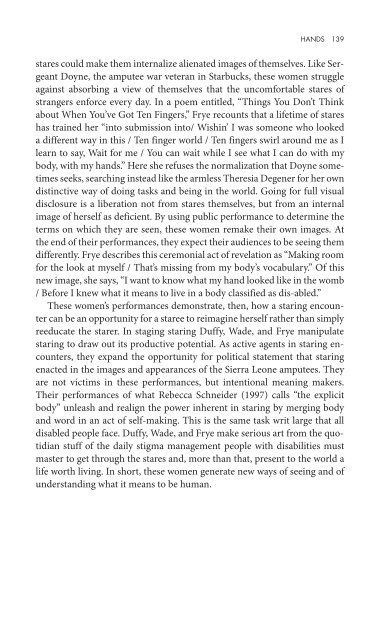Staring how we look sobre la mirada.pdf - artecolonial
Staring how we look sobre la mirada.pdf - artecolonial
Staring how we look sobre la mirada.pdf - artecolonial
You also want an ePaper? Increase the reach of your titles
YUMPU automatically turns print PDFs into web optimized ePapers that Google loves.
REGULATING OUR LOOKS 65<br />
<strong>Staring</strong>, as <strong>we</strong> saw, is curiosity’s vehicle. Disobedient <strong>look</strong>ing at a forbidden<br />
sight especially gets you into trouble. Pandora loosed the afflictions of the<br />
world because she could not resist peeking in at them. Lot’s wife turned into<br />
a pil<strong>la</strong>r of salt because she had to have one more <strong>look</strong> at the gruesome wreck<br />
of her home. An anxious over-the-shoulder double-check cost Orpheus his<br />
beloved Eurydice. Seven murdered previous wives assailed the curious eyes<br />
of Bluebeard’s new wife as she entered the forbidden castle chamber. Eyes<br />
that will not behave seem to be our undoing. Seneca warns rightly that curiosity<br />
is an affliction in which the eyes run away with the mind. Plutarch’s officious<br />
Lamia stores her eyes in a jar at night and puts them in again by day<br />
to gawk at the affairs of others. <strong>Staring</strong> is evidence of temptation in Christian<br />
thought. For Augustine curiosity is the sin of lusting with the eyes and<br />
the first move toward the deadly sin of pride. Evil, he specu<strong>la</strong>tes, might be<br />
avoided simply by shutting “the doors of his eye,” but perpetually the eyes fly<br />
open anew, overwhelmed by curiosity. Erotic or pornographic books <strong>we</strong>re<br />
known as “Curiosa” in <strong>la</strong>te nineteenth and t<strong>we</strong>ntieth-century Eng<strong>la</strong>nd. 2 In<br />
this tradition, staring is a visual vice, a defiant delinquency met with harsh<br />
censure.<br />
Curious <strong>look</strong>ing may be a path to noble discovery, as <strong>we</strong> have seen, but<br />
equally so it seems to be a route to catastrophe or triviality. What makes<br />
inquisitive <strong>look</strong>ing threatening or heroic is also what makes it feckless. <strong>Staring</strong><br />
is the opposite of keeping your nose to the grindstone. As a craving for<br />
stimu<strong>la</strong>tion in search of a target, staring is at once purposeless and purposeful,<br />
at one moment intrusion and the next idleness. One person’s remarkable<br />
scene is another person’s mundane <strong>la</strong>ndscape. To stare, then, is to barge into<br />
someone’s p<strong>la</strong>ce. As such, curious <strong>look</strong>ing is meddlesome, prying into someone<br />
else’s life. <strong>Staring</strong> is visual snooping.<br />
CIVILITY AND DECENT BEHAVIOR<br />
<strong>Staring</strong> puts us in one another’s faces. Contemporary America has responded<br />
to this uncomfortable exposure in part by fortifying the bulwark<br />
against staring bequeathed to us by the Western tradition. A <strong>we</strong>b of regu<strong>la</strong>tions<br />
aimed at mitigating staring’s interpersonal and social threat arose<br />
in American culture from its beginnings. Codes of propriety abound that<br />
attempt to spare us from being both starers and starees. Our mothers’ emphatic<br />
importuning against staring gets its authority from a long line of<br />
conduct manuals that detail proper behavior for <strong>look</strong>ing at one another.<br />
George Washington inaugurates these cautions in his collection of “Rules of<br />
Civility and Decent Behavior in Company and Conversation,” in which he


